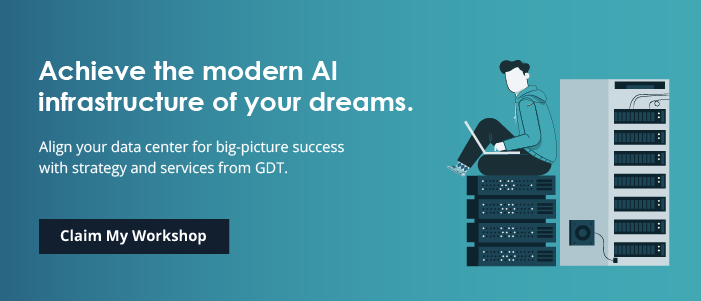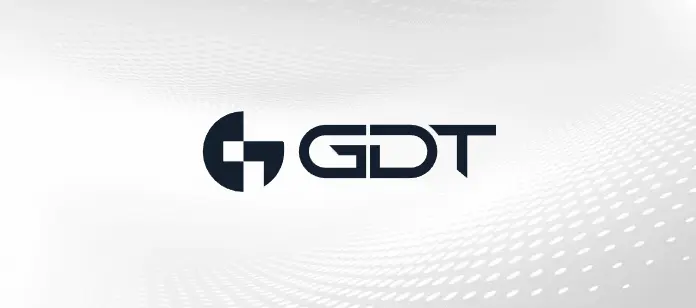Chances are, your organization is actively exploring AI modernization opportunities across your infrastructure, especially in the contact center and data center. In fact, you’ve likely already started your AI journey. Approximately one-third of organizations are investing in data center network upgrades over the next 12 months to meet the demands of generative AI (GenAI) and new applications and workloads.1

In this article, GDT experts Chris Kapusta, Director of Advisory and Transformation, and Kyle Dziubinski, Director of Collaboration & Contact Center, weigh in on the AI modernization trends, challenges, and opportunities they’re seeing in the contact center and beyond—and how to accelerate your own journey.
What are some of the AI modernization trends you’re seeing in the marketplace?
Chris: The age of AI curiosity has transitioned to the age of AI implementations. In 2023, we saw organizations taking a “wait-and-see” approach to AI. In 2024, we saw organizations starting to plan. Now, in 2025, they’re ready to execute. This is the year of AI execution.
Kyle: As an industry, we’ve evolved. CX conversational AI and intent-based routing were all the buzz the last couple of years, and we are talking to clients about agentic AI. Now there’s an uptick in agentic AI for coding assistants, customer care, and patient care. Agentic AI can resemble a highly trained agent that acts autonomously to make decisions and take action, solving customer use cases quickly and efficiently across all channels of contact.
What are some of the use cases for AI in the contact center space?
Kyle: While AI modernization projects can get a bit complicated, the upside is that there are plenty of use cases for AI, making that extra effort worthwhile. This is especially true in the collaboration and contact center space. What we’re seeing today is that AI curiosity is evolving into real projects, and businesses that jumped headfirst into AI are looking for better ways to implement AI in new ways and streamline their AI journey.
We’re seeing it in healthcare and other industries with use cases such as scheduling changes, prescription refills, payment services, customer request automation, ticket triage and resolution, follow-up automation…the list goes on.
What use cases are you seeing around physical AI?
Chris: Physical AI has come a long way, and we’ve seen some astoundingly useful applications across industries. Robots are being used in manufacturing settings to perform tasks like welding, assembly, and quality control. They’re being used in warehousing and logistics to pick, place, and transport products. They’re being used in hospitals to perform surgeries and transport supplies. Companies are using autonomous vehicles to transport people and drones to deliver packages. New uses continue to emerge.
What are some of the challenges businesses must overcome?
Kyle: As clients look to implement AI at scale to generate profit, improve customer service, or compete at a higher level, they often need someone to help them figure out exactly how to leverage AI in a way that’s secure, scalable, and cost-effective. The reality is that there are so many considerations. You have core applications, the phone system, the phones themselves, voicemail, a call center, which is omnichannel…. It’s a big topic, and figuring out, for example, how to leverage AI to automate things like appointment reminders and confirmations can be a huge challenge without the right expertise.
Businesses want to ensure the investments they put into new solutions tie back to tangible outcomes that will enhance the customer experience while driving efficiencies for the business. Just throwing AI at something won’t create a tangible outcome. Every business is different, and being smart and tactical will enhance the success of AI.
Chris: Of course, then there’s the infrastructure to support AI. Businesses struggle with the challenges of running AI infrastructure in data centers, which require significant power and cooling—and this will get even more challenging in the future. Right now, the NVIDIA Blackwell architecture requires 60-120 KW per rack. By 2027, power requirements will increase to 600 KW, and liquid cooling will be mandatory. In their 2025 Q1 earnings announcement, NVIDIA called this out, saying that 70% of data centers are below 20 KW per rack and that 62% of data centers will not have liquid cooling by 2026.2 Liquid cooling will be mandatory.
Additional consideration needs to be given to weight. Each DGX server weighs 290 lbs., each PDU weighs roughly 20 lbs., and each rack weighs another 300 lbs. That’s around 1,600 lbs. across two floor tiles—or seven tons per 32-node scaling unit. Data centers must be updated to support these new requirements, which is something that we’re helping clients work through.
How is GDT helping customers on their AI modernization journey?
Chris: From our perspective, we see three different types of businesses on the AI journey. The creators are building the AI models—companies like Microsoft, OpenAI, Meta, and Google. They need massive amounts of infrastructure.
Then there are the implementors who adapt existing models to feed in environment-specific data. They need infrastructure to train the new data. They need to secure and govern their data and power greater resiliency.
Finally, there are the users who are consuming the AI models built into everyday applications. There’s no ability to change or modify the data in these models, which are consumed as a service. These customers need guidance on how to adapt to using AI.
Clients are looking for cost-effective alternatives to using the cloud for their defined use cases. There are industry-specific use cases in retail, manufacturing, healthcare, and energy, oil, and gas. GDT can help with all of that. We have the advisory, data storage, and AI architecture expertise. We have the partnerships. We have the global staging and integration services needed to design, build, and deploy massive infrastructure in the data center to accelerate AI modernization. GDT offers the full breadth of support.
Talk about the concept of the AI factory.
Chris: Much like a physical factory that takes in materials, processes them, and outputs a product, an AI factory brings together AI, computing infrastructure, and data pipelines to generate AI models, insights, and automation solutions. This is something that NVIDIA CEO Jensen Huang has been advocating for. He predicts that AI factories will become just as essential as traditional factories in the modern economy. At the core is NVIDIA, which has moved beyond just thinking about GPUs, acknowledging that we need networking, storage, and compute to make this happen. So, the AI factory is comprised of all of those components working together.
How is GDT helping customers in the AI space?
Kyle: Some of our largest projects going right now are specific to the healthcare space, and we’re seeing tremendous upside and benefit. Projects include a full revamp of the patient and user experience, from the initial call, enabling conversational AI across dozens of languages, the customer journey, transcription, and across all verticals.
GDT has CX platform expertise and is an Epic development partner, which enables us to integrate AI features in CX tightly with Epic. Healthcare organizations can easily achieve a massive ROI by automating many of the common healthcare tasks, such as appointment scheduling, cancelation, and notifications; prescription refills; and FAQs, such as hours and location.
GDT has the ability to provide a real solution throughout, without creating a Frankenstein solution. Our tools and applications tightly integrate, so we can perform without introducing additional applications to the environment. Most importantly, we consult with clients and identify the areas where we can get those tangible outcomes.
Chris: We have multiple projects underway in different industries. Right now, we’re working with a law firm to wrap a large language model (LLM) around millions of documents from 30 years of case history. The goal is to streamline research around case outcomes and precedents and help inform current cases.
We’re working with a microchip manufacturer to wrap AI around chip-testing. We’re building out the networking, compute, GPU, and storage architecture they need to run AI models.
We’re also working with a county government to repatriate existing AI workloads running in the cloud to on-premises. Right now, we’re doing all the FinOps work to demonstrate how to do this more cost-effectively.
What can customers do to accelerate and streamline AI modernization?
Chris: When it comes to AI and AI infrastructure, GDT has a full breadth of services, expertise, and capabilities. I think the best place to start is with one of our workshops. We offer an AI Infrastructure Workshop that serves as an excellent jumping off point for customers that are trying to answer questions about AI, such as: what do I build? How do I build it? What infrastructure do I need? How do I scale? Some of our customers come to us because they don’t know where to start with AI. And some want to streamline and take their AI capabilities to the next level.
The AI Infrastructure Workshop is interactive, it’s complimentary, and it gives you direct access to our top experts. We work with you to figure out what your needs and challenges are, what your gaps and capabilities are, and what your desired end state should look like. Then we put together a high-level, prioritized roadmap that allows you to envision your path forward. Just reach out to schedule your AI Infrastructure Workshop.
About our experts
Chris Kapusta, Director of Advisory and Transformation, GDT

As the director of Advisory and Transformation at GDT, Chris Kapusta is responsible for the Data Center, Hybrid Cloud, and AI Practice. Chris and his team help clients with their digital transformation journey, engaging on projects involving data center and infrastructure modernization, developing hybrid cloud and multi-cloud strategies, and helping with AI initiatives. Chris has more than 25 years of experience in areas ranging from application development, data center infrastructure architecture, and performance management, to more recently, cloud and AI technologies. In his spare time, Chris enjoys hiking and downhill skiing with his family, reading horror novels, and playing taxi driver for his daughter’s way too many activities and hobbies.
Kyle Dziubinski, Director of Collaboration & Contact Center, GDT
Kyle Dziubinski leads GDT’s Collaboration and Contact Center Practice. Kyle joined GDT in September of 2024 when GDT acquired MDS Global IT, where Kyle was founder and CEO. Kyle brings deep collaboration and contact center expertise to GDT, complementing GDT’s industry-leading capabilities in networking, data center modernization, and security. Kyle has earned multiple certifications from Cisco and Microsoft, and has strong expertise in contact center architecture, Cisco systems products, and new business development. Kyle has founded multiple startups and is passionate about empowering his teams, delivering customer value, and innovating new solutions.
- Cisco, Global Networking Trends Reports (2024), found at: https://www.cisco.com/c/en/us/solutions/enterprise-networks/global-networking-trends.html ↩︎
- AllTechNerd, NVIDIA announces H200 NVL GPU focused on efficiency for data centers (2024), found at: https://www.alltechnerd.com/nvidia-announces-h200-nvl-gpu-focused-on-efficiency-for-data-centers/ ↩︎



